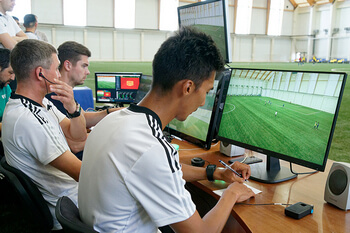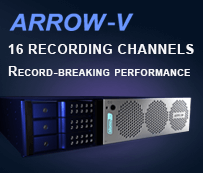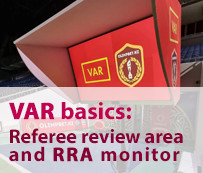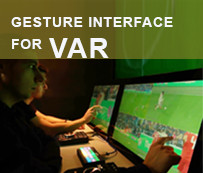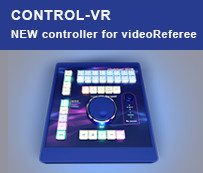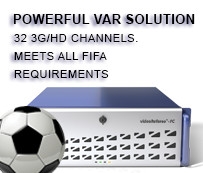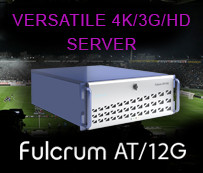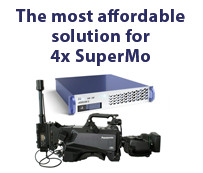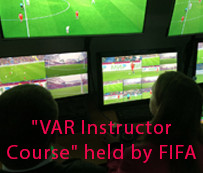The VAR system for football has both technical and human components. The technical component includes cameras, servers with controls, monitors, equipment in the RRA area, and a Referee Intercom system. This equipment is handled by engineers and is used by replay operators and VAR referees on one side, and referees on the pitch on the other.
All this forms the VAR complex.
The video assistance to the referees on the pitch is provided from a specialized dedicated location or Video Operation Room (VOR). So where should this "heart" of football video-refereeing be located?
It all depends on the cost and the geographical aspects. There are two main cases: local usage, when VAR equipment and VOR room are located at the arena, and centralized solution (VAR center). Let's talk about the pros and cons of the different VAR solutions. We will focus on solutions that use broadcast cameras.
VAR center. At the first glance, it seems to be the simplest and most logical solution. The whole complex is located in one geographically advantageous place.
VAR center allows covering the whole competition with a reasonably small number of servers (the number of parallel matches in the tournament + one spare) and does not require staff travel. VAR referees and operators are geographically separated from the game itself, which reduces the psychological pressure on them. It is also possible to train referees and operators on real matches by connecting signals to multiple VORs. They can practice and fine-tune their skills without affecting the game.
With the obvious benefits, the implementation of such a project involves a number of serious issues.
Challenges. The main and central task is the transmission of video signals from the cameras at the arena to the VAR center and the return communication channel between the referees on the pitch and the VOR room, as well as the signal to a monitor in the Referee Review Area (RRA).
While video calls are a standard feature inherent in any smartphone, it is not that simple. In football, the identification of the offside position is in the category of moments subject to video review. When analyzing these situations, it is necessary to determine the exact position of objects at the same moment in time on different cameras. This requires the video streams from the cameras to be synchronized. If non-synchronous cameras are used, standard Internet video streaming systems make it impossible to synchronize frames from different cameras in the VAR center. Things are better when using synchronous cameras, but if there is a desync, we cannot synchronize the streams on the receiving side.
The Internet connection must have low ping, which means you have to use broadcast-grade equipment to transmit video and have wide bandwidth to provide acceptable quality (approx. 150-200 Mbps for a single HD channel).
You also need a backup system because if the Internet connection is lost, the video material is not recorded by the VAR server.
Pros: Savings on equipment, space, people, travel and transportation costs. All signals come to one place. Ability to conduct training at real matches and organize video walls with signals from several matches.
Cons: High operational expenses of reliable Internet connection with low ping and large bandwidth, as well as expensive equipment to ensure high image quality. Difficulty with the communication channel and video to the RRA monitor, synchronization of video streams.
The implementation of such projects requires a lot of effort, financial and human resources.
Local usage - stationary and mobile systems. In this case, the entire VAR complex is located at the stadium. There are two approaches - stationary or mobile solution.
Stationary solution. This is the most reliable and simplest in terms of implementation. A special room is allocated in the arena, which permanently houses the equipment and a full-featured workplaces for the VAR team.
Pros: Reliability and ease of implementation. Independence from video streaming, no need for the video transmission equipment and expensive dedicated Internet-lines; no connection losses.
Cons: Equipment needs to be installed in each stadium. Additional costs for servers and VOR facilities. Possible psychological pressure on the VAR team.
Mobile solution - VAR Vans and portable sets. Mobile units have all the advantages of a stationary solution, and at the same time allows you to transport VAR equipment between stadiums.
When the lines and cables from the cameras to the location of the VAR system are already routed, you just need to connect to them. If it is not possible the routing of cables before every match requires a lot of manual work and increases the likelihood of problems
Some Federations and Leagues use a VAR Van with all the necessary equipment, including complete workstations for the replay operator, AVAR and VAR. How is this a better option than a stationary one?
Pros: High mobility and no need for a VOR room in each arena.
Cons: Cost of VAR Vans (most likely more than one) that meet all the requirements for power and safety. Unforeseen problems while traveling.
It is also possible to use flight sets. All VAR equipment is packed in special cases and transported between the stadiums.
Pros: Does not require purchase of VAR Van, use of ground transportation or air.
Cons: Requires organization of VOR room and setup before each match. Unforeseen situations during transportation and logistical issues.
Flight sets are quite popular. For example, they are used for important international competitions by the United World Wrestling and the International Swimming Federation (FINA) for water polo.
Hybrid solution. In this case, the server is located in the arena, but the workstations and the VAR team are in the VAR center. The workplaces and all controls are extended via the Internet.
Pros: Simple VAR center. Does not require an Internet connection with high bandwidth. In case of temporary connection loss, the recording of camera signals continues, because the server is located in the arena. When the connection is restored, a recording of the entire game is available. A certified engineer may be present in the arena to pick up the controls. All conveniences of VAR center, no need to travel, psychological security.
Cons: The solution is not suitable for everyone and requires an engineer in each arena. The cost can be either higher or lower than an organization of a VAR center. It depends on the specifics of the project.
Looking to the future. Perhaps in the future the optimal solution would be VAR centers utilizing H.264/H.265 video signals compression and low bitrate Internet lines. Such compression would reduce the required bandwidth by about 10 times. Low-cost, mass-produced H.264 encoding/decoding equipment can significantly reduce the cost of Internet connection lines and the equipment itself. The main problem in this case is the synchronization of video streams. Slomo.tv, the company I work for, already has the technology to synchronize frames not only from broadcast cameras, but also from prosumer and specialized video-refereeing cameras. We hope that this will lead to an improved version of the VAR center affordable to most leagues.



